“The sea appeared to have shrunk into itself, as if pushed back by the tremors of the earth…the banks had widened, and many sea creatures were beached on the sand. In the other direction gaped a horrible black cloud torn by sudden bursts of fire in snake-like flashes, revealing elongated flames similar to lightning but larger. And then came the ashes…”
– Pliny the Younger, 79 A.D., eyewitness account of the Mount Vesuvius eruption
In the early afternoon hours of August 24, 79 A.D. (darn, I should have waited four days for this tour so it’d be the anniversary) the volcano, Mount Vesuvius, exploded without warning. A torrent of ash and rock fragments ran down from the crater of the volcano through the city of Pompeii leaving destruction and death in its wake. The beautiful ancient city of Pompeii was left buried under 20 feet of dirt and ash. Pompeii was originally a third of a mile from the shoreline, but after the eruption the distance to the sea increased to one and a quarter miles! How’s that for landfill?
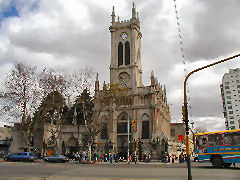 Now, it’s unlikely that Nueva Pompeya will have any volcanic eruptions – there are no volcanoes or even large hills nearby. It’s also not particularly ancient, having only become an official barrio in 1887. I’m not sure what it was called at that point, possibly colloquially it was referred to, as some writings indicate, simply “Pompeya”, but it wasn’t until three years later, in 1900, that local Capuchine priests dedicated the Sanctuary of the Virgin of Rosario of Pompeii, an event that led to the official naming of the barrio. I couldn’t find anything about when the “Nueva” was added. The neighborhood has, for many years, been home to a large Greek population, and, in fact, the San Nicolas Greek Orthodox Church and community center, a rather uninteresting building, especially when compared with the Santuario, has a large sign out front celebrating 75 years of serving the community.
Now, it’s unlikely that Nueva Pompeya will have any volcanic eruptions – there are no volcanoes or even large hills nearby. It’s also not particularly ancient, having only become an official barrio in 1887. I’m not sure what it was called at that point, possibly colloquially it was referred to, as some writings indicate, simply “Pompeya”, but it wasn’t until three years later, in 1900, that local Capuchine priests dedicated the Sanctuary of the Virgin of Rosario of Pompeii, an event that led to the official naming of the barrio. I couldn’t find anything about when the “Nueva” was added. The neighborhood has, for many years, been home to a large Greek population, and, in fact, the San Nicolas Greek Orthodox Church and community center, a rather uninteresting building, especially when compared with the Santuario, has a large sign out front celebrating 75 years of serving the community.
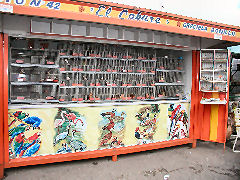 I was intrigued to head out to the neighborhood after my friend Barbara invited me a few weeks ago to accompany her to an offbeat street fair. I wasn’t able to go with her that day, and decided to go myself yesterday. Each Sunday, the parking area in between the Saenz rail station (Avenidas Saenz & Perito Moreno) and the neighborhood Mercado (some quite good butchers and vegetable stands) becomes the Fería de los Pajaros, or the Fair of the Birds. The name is both a clue to what to expect and misleading as well. It’s kind of a pet fair. Maybe a quarter to a third of it, and it’s not all that big, perhaps three dozen stands in total, are dedicated to birds – ranging from various songbirds in a rainbow of colors and chorus of voices to chickens, pigeons, quail, and pretty much any type of bird that someone thinks they might be able to sell. The remainder of the market is heavily focused on aquaria and fish – mostly goldfish (from small to koi), some guppies, and a few scattered others; a few mammal offerings like dogs, cats, and rabbits, and lots of stands that sell the various foodstuffs for different pets. The fair is teeming with people, and clearly quite popular, especially with kids.
I was intrigued to head out to the neighborhood after my friend Barbara invited me a few weeks ago to accompany her to an offbeat street fair. I wasn’t able to go with her that day, and decided to go myself yesterday. Each Sunday, the parking area in between the Saenz rail station (Avenidas Saenz & Perito Moreno) and the neighborhood Mercado (some quite good butchers and vegetable stands) becomes the Fería de los Pajaros, or the Fair of the Birds. The name is both a clue to what to expect and misleading as well. It’s kind of a pet fair. Maybe a quarter to a third of it, and it’s not all that big, perhaps three dozen stands in total, are dedicated to birds – ranging from various songbirds in a rainbow of colors and chorus of voices to chickens, pigeons, quail, and pretty much any type of bird that someone thinks they might be able to sell. The remainder of the market is heavily focused on aquaria and fish – mostly goldfish (from small to koi), some guppies, and a few scattered others; a few mammal offerings like dogs, cats, and rabbits, and lots of stands that sell the various foodstuffs for different pets. The fair is teeming with people, and clearly quite popular, especially with kids.
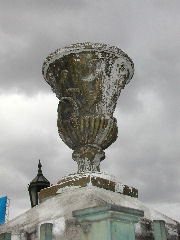 I had decided to expand my visit, given that it’s a bit of a bus ride to get there (though not nearly as long as I thought, only taking about half an hour on the bus after a 10-15 minute walk from home to the closest stop on a line going there), and had printed out the city government’s self-guided tour to the barrio. These tours are a great way to get a basic introduction to quite a few of the city’s barrios – it’s not complete by any means, either in barrios or in what to see in each, but each hits some key historical points. The site offers Spanish and English versions (though the English translations are clearly mechanical translations, and as such both amusing and frustrating), and there are both self-guided walks and lists of official guided tours along with time and place to meet. What I hadn’t thought about, was simply that in a non-touristy neighborhood, everything was closed on a Sunday.
I had decided to expand my visit, given that it’s a bit of a bus ride to get there (though not nearly as long as I thought, only taking about half an hour on the bus after a 10-15 minute walk from home to the closest stop on a line going there), and had printed out the city government’s self-guided tour to the barrio. These tours are a great way to get a basic introduction to quite a few of the city’s barrios – it’s not complete by any means, either in barrios or in what to see in each, but each hits some key historical points. The site offers Spanish and English versions (though the English translations are clearly mechanical translations, and as such both amusing and frustrating), and there are both self-guided walks and lists of official guided tours along with time and place to meet. What I hadn’t thought about, was simply that in a non-touristy neighborhood, everything was closed on a Sunday.
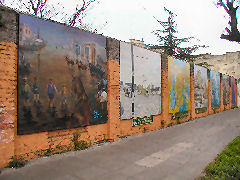 Really, virtually everything was closed. Even the churches were closed – the Santuario was in the process of locking its gates when I arrived at about 1:00, the Greek Orthodox church, which I got to about half an hour later, was tranquil and shuttered. Not a single restaurant with the exception of corner sandwich shops was open (a shame, I encountered a charming looking little restaurant at one corner on my walk, called quequerés?, or, to put it in newyorkese… “whaddayawant?” The museums were closed, as were all the other historic sites, with the exception of the outdoor plazas. Of most interest as I wandered is the large number of street murals, some of them at official historic sites,
Really, virtually everything was closed. Even the churches were closed – the Santuario was in the process of locking its gates when I arrived at about 1:00, the Greek Orthodox church, which I got to about half an hour later, was tranquil and shuttered. Not a single restaurant with the exception of corner sandwich shops was open (a shame, I encountered a charming looking little restaurant at one corner on my walk, called quequerés?, or, to put it in newyorkese… “whaddayawant?” The museums were closed, as were all the other historic sites, with the exception of the outdoor plazas. Of most interest as I wandered is the large number of street murals, some of them at official historic sites, 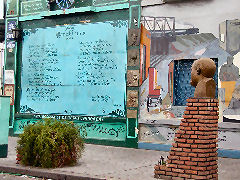 like this series of paintings depicting historical events in the barrio on the old paredón, or thick wall that used to prevent flooding (wait, there’s the potential natural disaster) along the southern edge of the old barrio; or the lyrics to the Manoblanca tango on the wall of the museum of the same name at the Esquina de los Poetas; and some of them just popping up in various plazas. Overall an enjoyable walk – it’s a shame that it’s impossible to combine the bird fair with the museums, they need to be done on separate days.
like this series of paintings depicting historical events in the barrio on the old paredón, or thick wall that used to prevent flooding (wait, there’s the potential natural disaster) along the southern edge of the old barrio; or the lyrics to the Manoblanca tango on the wall of the museum of the same name at the Esquina de los Poetas; and some of them just popping up in various plazas. Overall an enjoyable walk – it’s a shame that it’s impossible to combine the bird fair with the museums, they need to be done on separate days.
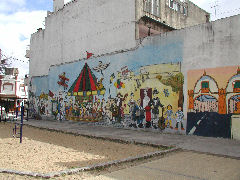
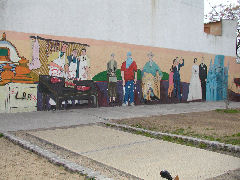
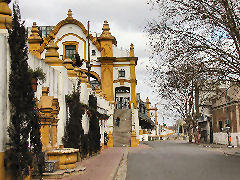 The best find on the walking tour was the amazing Puente Alsina, a stunning, mustard yellow colored bridge that includes both pedestrian and traffic lanes, crossing over the southern canal and highway to the suburban barrio of Lanús. There are a series of these bridges, each with completely different designs, that surround the city. Some of them are quite simple, modern roads, and others are just plain impressive architecture, like this one. It’s worth the trip in and of itself. If you head to the fería one Sunday (open, by the way, from 8 a.m. to 2 p.m.), just continue down Av. Saenz to the bridge. Save the rest of the tour for a week day when you can see the museums and churches (I suppose, if one went earlier in the morning, one could get into the churches during mass).
The best find on the walking tour was the amazing Puente Alsina, a stunning, mustard yellow colored bridge that includes both pedestrian and traffic lanes, crossing over the southern canal and highway to the suburban barrio of Lanús. There are a series of these bridges, each with completely different designs, that surround the city. Some of them are quite simple, modern roads, and others are just plain impressive architecture, like this one. It’s worth the trip in and of itself. If you head to the fería one Sunday (open, by the way, from 8 a.m. to 2 p.m.), just continue down Av. Saenz to the bridge. Save the rest of the tour for a week day when you can see the museums and churches (I suppose, if one went earlier in the morning, one could get into the churches during mass).
Your review of this barrio is so superior to all other mentions I found of it online in the last 3 hours. Yours provides a tangible ‘feel’ of the place, something that the city’s published walks and other descriptions leave out entirely. Thank you especially for naming the ‘bird market’ in Spanish in an English article -very useful if I should get lost! And thanks equally for letting us know that you can’t eat at restaurants or visit museums on the same day as visiting the bird/animal market.
You’re welcome! I plan to go back again sometime and see a bit more when things are open.